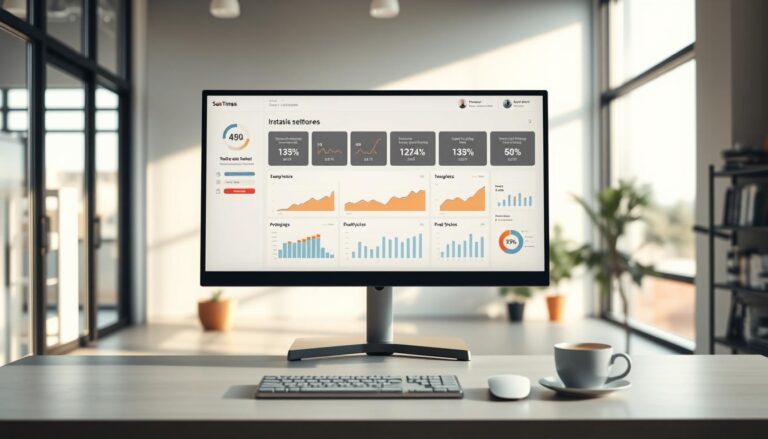AI-driven GTM data analytics is changing how companies make strategic decisions. Using artificial intelligence, firms can now look at past and current data in useful ways. This helps improve marketing plans and sales. Before, companies had to rely on guesswork and little information. But now, with AI, the way businesses understand their markets is transforming.
This change is making it easier to predict future trends. It also gives companies a way to stay ahead in a constantly changing market.
Key Takeaways
- AI-driven GTM data analytics enhances strategic decision-making.
- Artificial intelligence improves data analysis effectiveness.
- Data-driven decision-making with AI leads to better predictions.
- Organizations can optimize marketing strategies through advanced analytics.
- AI integration offers a competitive edge in fast-paced markets.
Understanding AI-Driven GTM Data Analytics
GTM data analytics looks at market strategies, customer behaviors, and competitive landscapes. It aims to improve how businesses enter markets and refine their sales strategies. By analyzing different types of data, like sales numbers and customer opinions, companies can make smarter choices.
Definition of GTM Data Analytics
GTM data analytics reviews how well a company introduces its products to the market. It offers deep insights into what customers need and what competitors are doing. This is crucial for businesses wanting to grow. Using advanced analytics helps increase market share and customer happiness.
Importance of AI in Data Analytics
Artificial Intelligence (AI) is transforming how we turn raw data into valuable insights. With machine learning, companies can quickly and accurately go through tons of information. This lets them adapt to market changes fast, keeping them ahead in the game. AI is essential for predicting future trends and improving strategies now.
Key Characteristics of AI-Driven Solutions
AI-driven solutions stand out because they can handle loads of data while giving insights in real time. They use predictive analytics to guess market trends and customer needs well. Having AI for GTM means businesses can quickly adapt to what customers want.
| Characteristic | Description |
|---|---|
| Data Management | Ability to handle high volumes of data efficiently |
| Automation | Streamlining data processes to save time and improve accuracy |
| Real-Time Insights | Providing immediate access to relevant data for timely decisions |
| Predictive Analytics | Forecasting trends to aid in strategic planning |
The Role of Data in Strategic Decision-Making
Data is vital for making smart choices in business. Understanding the kinds of data used in GTM analytics helps businesses get better at data-driven decision-making with AI. Good data lays the groundwork for useful insights, leading to better results.
Types of Data Used in GTM Analytics
GTM analytics use different types of data to fully understand market behavior. Key types include:
- Behavioral Data: This type shows how people use products and services. It offers crucial info on customer habits.
- Demographic Data: It helps businesses find and focus on their main customers.
- Market Trends: Keeping up with trends helps businesses stay ahead by adapting their strategies.
- Feedback Loops: It’s important to collect customer feedback to improve products and customer service.
Data Quality and its Impact on Decisions
The quality of data greatly affects gtm data insights with artificial intelligence. Good, well-organized data leads to precise analysis, while bad data can mess up the findings. Making sure data is reliable and consistent reduces the chance of mistakes in decision-making. The right data is key to creating predictive models that boost sales and make customers happier.
For more info, check out this guide on ai-driven customer segmentation in modern marketing.
Benefits of AI-Driven GTM Data Analytics
Adding AI-driven GTM data analytics helps businesses improve how they make decisions and stay ahead. These technologies allow for better insight, smoother operations, and smarter planning. Here are some major benefits.
Enhanced Insights and Predictive Capabilities
AI tools dig into big data to find trends and customer habits that were once hidden. They help businesses make smart guesses about future trends. This leads to better planning and marketing focused on what customers want.
Increased Efficiency in Decision-Making
AI speeds up data analysis, letting teams think more about strategy and less about gathering info. This shift makes every department more productive. Faster, smarter decisions mean a company can quickly adapt to new market trends.
Competitive Advantage through Data-Driven Strategies
Using AI analytics gives companies an edge by making strategies based on solid data, not guesses. This leads to better customer targeting and happiness. Staying ahead in a competitive market becomes easier.
Key Technologies in AI-Driven Analytics
Knowing the tech behind AI-driven analytics boosts businesses in making smart decisions from data. These technologies are key to unlocking valuable insights and improving how a company performs. Here’s a look at the main tech that shapes AI analytics.
Machine Learning Algorithms
Machine learning algorithms are vital for analyzing huge amounts of data. They help businesses foresee trends and adapt their strategies quickly. This means companies can adjust to market changes fast, staying ahead of competitors.
Natural Language Processing
Natural language processing (NLP) lets companies understand what customers are saying in texts. By using NLP, businesses can make their customer service better and more personal. It also helps them update their products to match what customers want, boosting growth.
Big Data Technologies
Big data tools like Hadoop and Apache Spark let businesses handle and analyze big data. They help businesses grow their AI analytics capabilities. With these technologies, companies can sort through data fast, making smart decisions quickly.

Implementation Strategies for Businesses
For businesses to use AI-driven analytics well, they need a plan made just for them. Adding these analytics carefully helps businesses improve how they introduce products to the market. We will talk about how to bring analytics into a company, handle data best, and solve problems that come up.
Steps to Integrate AI-Driven Analytics
Starting to use AI for bettering how you reach the market begins with looking at your current methods. It’s important to find spots where AI can help make better decisions based on data. Set goals for using AI that match up with what the business wants to achieve. Before choosing tools for AI, gather and clean up data from different sources.
Try these tools out in pilot programs to see if they work well. This step lets companies adjust things as needed before going all in.
Best Practices for Data Management
For data analytics to work best, firms must take care of their data. This means keeping data accurate and well-managed, which is key for AI to help in reaching markets better. Getting teams from different areas to work together shares knowledge and builds a focus on data.
Keep teaching your team about AI and data changes. This helps everyone understand how AI fits into the business plan.
Addressing Challenges in Implementation
Companies must be ready to deal with issues when adding AI analytics. Problems might include data being poor quality, people not liking new ways, and fitting AI with old systems. Working on solutions like training and being open to new technologies can lower these risks and increase productivity.
| Challenge | Solution |
|---|---|
| Data Quality Issues | Implement rigorous data cleaning processes and regular audits. |
| Cultural Resistance | Provide training and promote a positive view of AI and analytics. |
| System Integration | Choose tools that easily integrate with existing platforms, and conduct pilot tests. |
Case Studies of Successful AI-Driven Analytics
Real-world examples show us how companies are winning with ai-driven gtm data analytics. These case studies spotlight the major changes analytics bring to firms. They show us varied methods and results.
Company A: Transforming Decision-Making
A top retail firm got ahead by using ai-driven gtm data analytics for smart choices. This move majorly cut down their supply chain costs by 30%. Such smart data use not only saved them money. It also made sure they had what customers wanted, boosting sales and their money matters.
Company B: Leveraging Data for Market Insights
An up-and-coming tech startup tapped into ai-driven gtm data analytics to watch and learn from user actions. This insight let them create custom solutions faster than rivals. Thanks to being data-smart, they saw more users stick around and more new ones join. This success story underlines the power of knowing the market through data.

| Company | Strategy | Outcome |
|---|---|---|
| Company A | AI-driven supply chain analytics | 30% reduction in operational costs, improved stock management |
| Company B | Data analysis for market trends | Increased user acquisition and customer retention rates |
Future Trends in AI-Driven GTM Analytics
The world of AI-driven GTM analytics is quickly changing. It’s influenced by things like new tech and the need for better data use in making big decisions. We see changes in technology, what customers expect, and new rules to follow.
Emerging Technologies and Innovations
Soon, we will see big steps forward with new AI, deep learning, and better safety for our data. Companies will get to use AI made just for them, helping them make smarter choices. These new tech pieces make it easier for businesses to get better at analyzing data.
Evolving Consumer Expectations
Consumers now know more about tech and want things made just for them. Companies need to use their GTM plans to meet these demands. Using AI to understand these needs helps companies give people exactly what they want.
Regulation and Ethical Considerations
As more companies use advanced data, rules about data privacy and being clear about algorithms will get stricter. Companies have to use data the right way and follow these new rules. This keeps customers’ trust and avoids any legal trouble, all while using AI’s benefits.
To learn more about how AI will change the way we market, check out this detailed look at AI’s role in analytics.
Conclusion: The Impact of AI on Strategic Decision-Making
Throughout this article, we’ve seen how AI helps in GTM data analytics for businesses. These advanced tools help identify trends and understand what customers like. This leads to better choices, increasing a company’s market share.
Also, AI makes companies more efficient. It lets them quickly adjust to changes in the market.
The use of AI in business strategies is not just helpful; it’s crucial. It lets companies offer personalized services based on up-to-date data. In a competitive world, using AI is key to staying ahead and being successful.
With AI, companies can be one step ahead and keep their edge in the market. It helps them stay proactive, not just react to changes.
FAQ
What is GTM data analytics?
GTM data analytics looks at market strategies, customer actions, and competitive fields. It uses different types of data, such as sales numbers and consumer feelings. This info helps make good decisions.
How does AI enhance data analytics?
AI changes raw data into insights by speeding up analysis. It uses learning models to predict and tweak strategies. This is key for fast adjusting to market changes.
What are the key benefits of AI-driven GTM analytics?
AI-driven GTM analytics offers better insights and future seeing. It makes decision-making faster, giving an edge with data strategies. Firms can shape their methods with exact data, raising targeting and customer happiness.
What types of data are important in GTM analytics?
Key data in GTM analytics include customer actions and demographic info, market trends, and feedback. Analyzing customer interactions guides product interactions. Demographic data helps in dividing the market properly.
What challenges do organizations face when implementing AI-driven analytics?
Organizations may hit hurdles like poor data quality, resistance to new culture, and tech troubles. Offering training and encouraging an AI-ready culture helps overcome these.
How can companies ensure data quality for accurate analysis?
Companies must keep their data high-quality, organized, and useful. Setting data rules and checking data’s accuracy and consistency are key. This reduces risks and boosts decision-making.
What role do machine learning algorithms play in GTM analytics?
Machine learning figures out patterns in big data sets. It improves predictions, allowing firms to update marketing and sales plans with current data insights.
What is the significance of natural language processing in GTM analytics?
Natural language processing (NLP) helps businesses understand customer texts. Analyzing talks and feelings guides better customer engagement and refines products based on feedback and trends.
How do emerging technologies impact AI-driven GTM analytics?
New tech like generative AI and blockchain change AI analytics. Custom AI solutions will grow for different sectors, upgrading strategies and insights.
What should businesses prioritize to successfully integrate AI-driven analytics?
Businesses should check their current GTM strategies for AI use, set clear goals, manage data, and choose the right tools. Testing pilots before full use is essential.



